List of Indiana state symbols
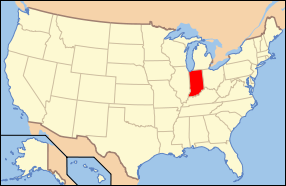
The U.S. state of Indiana has 12 official state emblems, as well as other designated official items. The majority of the symbols in the list are officially recognized and created by an act of the Indiana General Assembly and signed into law by the governor. They are listed in Indiana Code Title 1, Article 2, State Emblems which also regulates the appearance and appliciple use of the items.[1]
Compared to other states, Indiana has few official symbols. The first symbol was the Seal of Indiana, which was made official in 1801 for the Indiana Territory and again in 1816 by the state of Indiana.[2] It served as the state's only emblem for nearly a century until the adoption of the state song in 1913.[3] For many years, Indiana was the only state without a flag. The official state banner was adopted in 1917, and renamed the state flag in 1955.[4] The newest symbol of Indiana is the state pie, sugar cream, assigned in 2009.
Contents |
Insignia
| Type | Symbol | Description | Year | Image | Note |
|---|---|---|---|---|---|
| Flag | The flag of Indiana | Indiana's flag has a blue background with a torch in the center. the torch is surrounded by nineteen stars, thirteen representing the original colonies, five the next five states, and one Indiana. | 1917 | 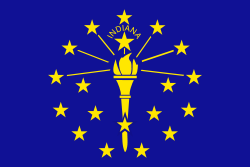 |
[5] |
| Motto | The Crossroads of America | Indiana is the site of many cross-country roads, including the National Road and U.S. Route 41. | 1937 | 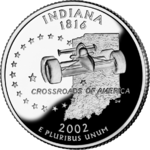 |
[6] |
| Nickname | The Hoosier State | Indiana residents are known as Hoosiers, a word of unknown origin. | Traditional |
—
|
[6] |
| Seal | The seal of Indiana | Indiana's seal depicts a setting sun, sycamore trees, a woodsman, and a jumping buffalo. | 1963 | 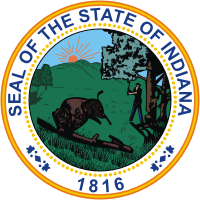 |
[7] |
| Slogan | Restart your Engines | The slogan alludes to the Indianapolis 500, which is begun with the quote "Gentlemen, start your engines." | April 19, 2006 |
—
|
[8][A] |
Species
| Type | Symbol | Description | Year | Image | Note |
|---|---|---|---|---|---|
| Bird | Cardinal Cardinalis cardinalis |
The male cardinal is bight red and the female is brown and dull red. They live in Indiana year-round. | 1933 | 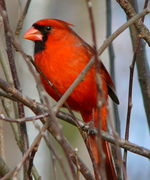 |
[9][B] |
| Flower | Peony Paeonia |
The peony is a red, pink, or white flower that blooms in late May. It is grown throughout Indiana. | 1957 | 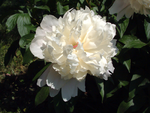 |
[10][C] |
| Tree | Tulip tree Liriodendron tulipifera |
The tulip tree is also called the yellow poplar. It has a distinctive leaf shape and yellow, bell-shaped flowers. It is a tall tree and grows throughout Indiana. | March 3, 1931 |  |
[11] |
Geology
| Type | Symbol | Description | Year | Image | Note |
|---|---|---|---|---|---|
| River | Wabash River | The Wabash is the longest river in Indiana. It flows from Ohio across Northern Indiana until it forms the border between Indiana and Illinois. | 1996 | 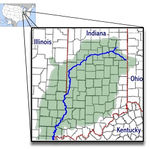 |
[12] |
| Soil | Miami | Miami soil is used to grow corn and soybeans, Indiana's primary crops. It is a brown silt loam that is highly productive and wide-spread in Indiana. |
—
|
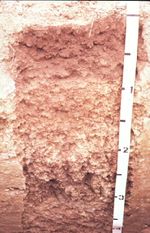 |
[13] |
| Stone | Limestone | The Indiana variety of limestone, also called Salem or Bedford, is significantly quarried in south-central Indiana. It is a high-quality stone that has been used in buildings such as the Empire State Building and the Pentagon. | 1971 |  |
[14] |
Culture
| Type | Symbol | Description | Year | Image | Note |
|---|---|---|---|---|---|
| Beverage | Water | Water is vital for human survival. | 2007 | 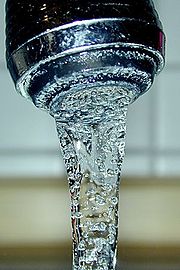 |
[15] |
| Language | English | English is the native language of over 95% of the state's residents. | 1984 |
—
|
[16][D] |
| Holidays | George Rogers Clark Day, February 25 (1779) Northwest Ordinance Day, July 13 (1787) Indiana Day, December 11 (1816) |
Celebrates the surrender of Fort Sackville Celebrates the adoption of the Northwest Ordinance Celebrates Indiana's admittance to the United States |
1975 1988 1925 |
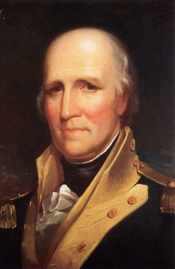 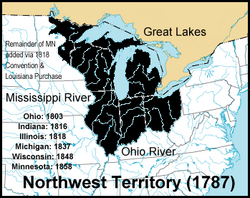 |
[17] [18] [19] |
| Pie | Hoosier Pie (Sugar cream pie) | Sugar cream pie is an Indiana tradition coming from Amish and Shaker communities. | January 23, 2009 |  |
[20] |
| Poem | "Indiana" By Arthur Franklin Mapes |
"Indiana" is a poem describing the state's natural beauty. | 1963 |
—
|
[21] |
| Song | "On the Banks of the Wabash, Far Away" By Paul Dresser |
This song describes the author's past along the Wabash River. | March 14, 1913 |  |
[22] |
Notes
- A The slogan was formerly Enjoy Indiana.[8]
- B At the time, the Northern Cardinal's scientific name was Richmondena Cardianalis Cardinalis. It was changed in 1983.[23]
- C From 1923 to 1931, the state flower was the flower of the tulip tree. From 1931 to 1957, the state flower was the Zinnia.[24]
- D American Sign Language was recognized as an independent language in 1995.[16]
See also
- Lists of United States state insignia
References
- ↑ "IC 1-2". Indiana Code. Indiana Office of Code Revision. http://www.in.gov/legislative/ic/code/title1/ar2/. Retrieved 2009-08-20.
- ↑ "Indiana's State Seal—An Overview". Indiana Historical Bureau. http://www.in.gov/history/2804.htm. Retrieved 2008-01-28.
- ↑ "Paul Dresser". Indiana Historical Society. http://www.indianahistory.org/pop_hist/people/dresser.html. Retrieved 2009-03-14.
- ↑ "Indiana's State Banner". Indiana Historical Bureau. http://www.in.gov/history/2687.htm. Retrieved 2008-06-01.
- ↑ "Indiana State Flag". Indiana Historical Bureau. http://www.in.gov/history/2797.htm. Retrieved 2008-01-28.
- ↑ 6.0 6.1 "State emblems". Indiana Historical Bureau. http://www.in.gov/history/2329.htm. Retrieved 2009-08-20.
- ↑ "Indiana State Seal". Indiana Historical Bureau. http://www.in.gov/history/2803.htm. Retrieved 2008-01-28.
- ↑ 8.0 8.1 "Indiana Tourism Revs Up New Brand Campaign". Inside Indiana Business. http://www.insideindianabusiness.com/newsitem.asp?ID=17657. Retrieved 2009-08-22.
- ↑ "Indiana State Bird". Indiana Historical Bureau. http://www.in.gov/history/2796.htm. Retrieved 2008-01-28.
- ↑ "Indiana State Flower". Indiana Historical Bureau. http://www.in.gov/history/2798.htm. Retrieved 2008-01-28.
- ↑ "Indiana State Tree". Indiana Historical Bureau. http://www.in.gov/history/2798.htm. Retrieved 2008-01-28.
- ↑ "Indiana State River". Indiana Historical Bureau. http://www.in.gov/history/2799.htm. Retrieved 2008-01-28.
- ↑ "Miami—Indiana's State Soil" (PDF). United States Department of Agriculture. ftp://ftp-fc.sc.egov.usda.gov/NSSC/StateSoil_Profiles/in_soil.pdf. Retrieved 2007-12-27.
- ↑ "Indiana State Stone". Indiana Historical Bureau. http://www.in.gov/history/2799.htm. Retrieved 2008-01-28.
- ↑ Biddle, RiShawn (March 19, 2007). "Naming water the official drink of Indiana -- and other legislative silliness.". The Indianapolis Star. http://blogs.indystar.com/expresso/archives/2007/03/making_water_th.html. Retrieved 2007-11-23.
- ↑ 16.0 16.1 "Indiana State Language". Indiana Historical Bureau. http://www.in.gov/history/2802.htm. Retrieved 2008-01-28.
- ↑ "IC 1-1-13". Indiana Code. State of Indiana. http://www.in.gov/legislative/ic/code/title1/ar1/ch13.html. Retrieved 2007-12-27.
- ↑ "IC 1-1-14". Indiana Code. State of Indiana. http://www.in.gov/legislative/ic/code/title1/ar1/ch14.html. Retrieved 2007-12-27.
- ↑ "IC 1-1-10". Indiana Code. State of Indiana. http://www.in.gov/legislative/ic/code/title1/ar1/ch10.html. Retrieved 2007-12-27.
- ↑ Baldino, Megan (January 29, 2009). "It's official: Indiana's state pie is the sugar cream". WSBT-TV. http://www.wsbt.com/news/local/38610802.html. Retrieved 2009-08-20.
- ↑ "Indiana State Poem". Indiana Historical Bureau. http://www.in.gov/history/2801.htm. Retrieved 2008-01-28.
- ↑ "Indiana State Song". Indiana Historical Bureau. http://www.in.gov/history/2800.htm. Retrieved 2008-01-28.
- ↑ Ritchison, Gary (1997). Wild bird guides. Stackpole Books. p. 2. ISBN 0811731006. http://books.google.com/books?id=mwY9HFMWkbsC&pg=PA2&lpg=PA2&dq=Richmondena+Cardinalis+Cardinalis+name+change&source=bl&ots=L6nE3AaD4A&sig=rIK_ivxVS37jSXEpa7NVe-b2rSo&hl=en&ei=doaQSqSoKuaStgfLvY3PBA&sa=X&oi=book_result&ct=result&resnum=1#v=onepage&q=Richmondena%20Cardinalis%20Cardinalis%20name%20change&f=false. Retrieved 2009-08-22.
- ↑ "State Tree of INDIANA". Indiana Woodland Steward. Purdue University. http://www.fnr.purdue.edu/inwood/state%20tree%20poster.htm. Retrieved 2007-11-23.
External links
- "Indiana Code Title 1, Article 2 Table of Contents". Indiana General Assembly. http://www.in.gov/legislative/ic/code/title1/ar2/. Retrieved 2007-12-27.
- "Emblems of the State of Indiana". Indiana Historical Bureau. http://www.in.gov/history/2329.htm. Retrieved 2008-01-28.
- "Facts about Indiana: State Emblems". VisitIndiana.com. http://www.in.gov/visitindiana/about/emblem.aspx. Retrieved 2008-08-20.
|
||||||||||||||||||||
|
||||||||